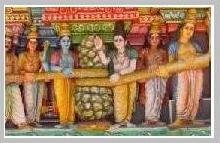Sanjhi, an ancient Vaishnava art, involves cutting paper to form intricate stencils depicting the life of Krishna and Radha. The stencils are used in different ways. Some are placed on freshly plastered mud walls and filled with coloured powder. Some are placed on plates smeared with mustard oil. After filling the stencil with various powders, the stencil is lifted gently and the plate made to float on the river. The heavy plate is then taken out as it goes down leaving only the beautiful Sanjhi floating on a bed of oil! Folklore has it that since the artists started working in the morning but displayed the creation only in the evening, the art got named Sanjhi, Hindi for evening. In modern times, the stencils are made on rice paper and other strong materials to be made into lamp shades and other utility products. The art has also found acceptance as bindis to adorn foreheads.
"Athato Brahma-Jijnasa.. Now in this human form of life, inquire about the absolute truth". - Vedanta Sutra -



The demigods (suras) and demons (asuras) undertook the Churning of the milk-ocean to obtain the nectar of immortality.
Dhara Kaho He
Ruddha Habe Nai
**********************
The Divine Current
will never be Obstructed.
Ruddha Habe Nai
**********************
The Divine Current
will never be Obstructed.

A.C. Bhaktivedanta Swami
Tools
Look Here:
- www.Dharmakshetra.com
- Vedic Treasure
- Figure of beauty
- Lives of the Saints
- Ohe Vaisnava
- Birds & Plants mentioned in Vaisnava Literature
- A Garland of Prayers
- Brahmaji appears in a flash
- A humble recipe link
- Flash and Slide ..Shows
- O Sri Vrindavan
- Radha Shyamsundar's Website
- Rasikananda's Syamananda Sataka
- Saranagati by Srila Bhaktivinode
- Sri Gadadharastakam
- Sri Gopal Tapani Upanishad
- Old Pages
- Puranic Time Measurements "Explained".
- Feast for the Eyes
- Ekadasi and Caturmasya Guidelines

SRIMAD-BHAGWATAM is mula-pramana, the original root of all Vedic evidence.


............... Divine Soil ...........

Blog Archive
-
▼
2009
(148)
-
▼
August
(17)
- :-) Conversation with God (-:
- Vrshabanu-nandini-Sri Radha
- Krishna's bellicose activities
- Dosa Pancakes
- Non Sectarian
- Cowherd boys
- Ancient Vaishnava Art
- Mahaprabhu Diety
- An Ancient Text
- Sridham's charming younger sister
- One drop of nectar
- King Kamsa It appears that King Kamsa is at...
- Mode of Judgement
- Hankering for pure love
- Unmilked utters
- Give me shelter
- True followers
-
▼
August
(17)


Gopijana ballavah..Kunjabi Hari


The Bhagavad Gita manifested 3137 BC at Kurukshetra, India


The four legs of the Holy bull ( Dharma ) represent austerity, cleanliness, mercy and truthfulness.


Prasadam (mode of goodness foodstuffs, prepared and offered to Krsna with love and devotion)

Hearing the Karatals resound, and the Mrdangas playing sweetly, everyone will feel great satisfaction

Simply by seeing, touching, remembering, praying to, bowing before, hearing about or simply by sowing this tree, there is always auspiciousness.

